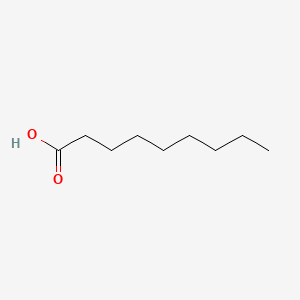| MeSH term | MeSH ID | Detail |
|---|---|---|
| Dermatitis, Contact | D003877 | 59 associated lipids |
| Facial Dermatoses | D005148 | 7 associated lipids |
| Hypersensitivity | D006967 | 22 associated lipids |
| Arteriosclerosis | D001161 | 86 associated lipids |
| Seizures | D012640 | 87 associated lipids |
| Dermatitis, Allergic Contact | D017449 | 20 associated lipids |
| Riboflavin Deficiency | D012257 | 10 associated lipids |
| Lichen Planus | D008010 | 3 associated lipids |
| Keratosis | D007642 | 9 associated lipids |
| Tick Infestations | D013984 | 4 associated lipids |
NONANOIC ACID
NONANOIC ACID is a lipid of Fatty Acyls (FA) class. Nonanoic acid is associated with abnormalities such as megalocytosis, Hypos, Renal tubular disorder, Respiratory Distress Syndrome, Adult and Little's Disease. The involved functions are known as Gene Expression, Signal Transduction, Regulation, Cell Cycle and Force. Nonanoic acid often locates in Membrane, Protoplasm, Body tissue, Extracellular and Cell membrane. The associated genes with NONANOIC ACID are cysteinylglycine, glycylsarcosine, arginine methyl ester, GLI3 gene and ADRBK1 gene. The related lipids are 1-octen-3-ol, Butyric Acids, palmitoleic acid, pentadecanoic acid and stearic acid.
Cross Reference
Introduction
To understand associated biological information of NONANOIC ACID, we collected biological information of abnormalities, associated pathways, cellular/molecular locations, biological functions, related genes/proteins, lipids and common seen animal/experimental models with organized paragraphs from literatures.
What diseases are associated with NONANOIC ACID?
NONANOIC ACID is suspected in megalocytosis, Hypos, Renal tubular disorder, Respiratory Distress Syndrome, Adult, Little's Disease and other diseases in descending order of the highest number of associated sentences.
Related references are mostly published in these journals:
- Am. J. Physiol. Lung Cell Mol. Physiol. (1)
- Am. J. Physiol. Renal Physiol. (1)
- Dis Model Mech (1)
- Others (1)
| Disease | Cross reference | Weighted score | Related literature |
|---|
Possible diseases from mapped MeSH terms on references
We collected disease MeSH terms mapped to the references associated with NONANOIC ACID
PubChem Associated disorders and diseases
What pathways are associated with NONANOIC ACID
There are no associated biomedical information in the current reference collection.
PubChem Biomolecular Interactions and Pathways
Link to PubChem Biomolecular Interactions and PathwaysWhat cellular locations are associated with NONANOIC ACID?
Visualization in cellular structure
Associated locations are in red color. Not associated locations are in black.
Related references are published most in these journals:
- Am. J. Physiol. Heart Circ. Physiol. (4)
- Am. J. Physiol. Lung Cell Mol. Physiol. (1)
- Am. J. Physiol., Cell Physiol. (1)
- Others (6)
| Location | Cross reference | Weighted score | Related literatures |
|---|
What functions are associated with NONANOIC ACID?
Related references are published most in these journals:
| Function | Cross reference | Weighted score | Related literatures |
|---|
What lipids are associated with NONANOIC ACID?
Related references are published most in these journals:
| Lipid concept | Cross reference | Weighted score | Related literatures |
|---|
What genes are associated with NONANOIC ACID?
Related references are published most in these journals:
- Am. J. Physiol. Heart Circ. Physiol. (2)
- Am. J. Physiol. Lung Cell Mol. Physiol. (1)
- J. Biol. Chem. (1)
- Others (3)
| Gene | Cross reference | Weighted score | Related literatures |
|---|
What common seen animal models are associated with NONANOIC ACID?
There are no associated biomedical information in the current reference collection.
NCBI Entrez Crosslinks
All references with NONANOIC ACID
Download all related citations| Authors | Title | Published | Journal | PubMed Link |
|---|---|---|---|---|
| Reiche L et al. | Clinical morphology of sodium lauryl sulfate (SLS) and nonanoic acid (NAA) irritant patch test reactions at 48 h and 96 h in 152 subjects. | 1998 | Contact Derm. | pmid:9840260 |
| Montelius J et al. | Murine local lymph node assay for predictive testing of allergenicity: two irritants caused significant proliferation. | 1998 | Acta Derm. Venereol. | pmid:9833042 |
| Forsey RJ et al. | Epidermal Langerhans cell apoptosis is induced in vivo by nonanoic acid but not by sodium lauryl sulphate. | 1998 | Br. J. Dermatol. | pmid:9767290 |
| Tetrick MA et al. | Synthesis of [9-14C]nonanoic acid via 2-thienyl(14CH3)(cyano)cuprate and its oxidation by newborn piglet muscle strips. | 1997 | Anal. Biochem. | pmid:9177718 |
| Grängsjö A et al. | Different pathways in irritant contact eczema? Early differences in the epidermal elemental content and expression of cytokines after application of 2 different irritants. | 1996 | Contact Derm. | pmid:9118630 |
| Seidenari S | Image processing of 20 MHz B-scan recordings of irritant reactions. | 1995 | Curr. Probl. Dermatol. | pmid:9035910 |
| Hümpel M et al. | Injectable depot contraceptives on d-norgestrel basis. I. Pharmacokinetic studies in dog and baboons. | 1977 | Contraception | pmid:880816 |
| Curley JM et al. | Sequential production of two different polyesters in the inclusion bodies of Pseudomonas oleovorans. | 1996 | Int. J. Biol. Macromol. | pmid:8782716 |
| Nicander I et al. | Correlation of impedance response patterns to histological findings in irritant skin reactions induced by various surfactants. | 1996 | Br. J. Dermatol. | pmid:8746333 |
| Andersen PH and Maibach HI | Skin irritation in man: a comparative bioengineering study using improved reflectance spectroscopy. | 1995 | Contact Derm. | pmid:8565486 |
